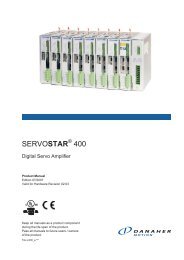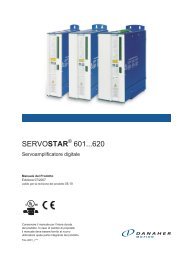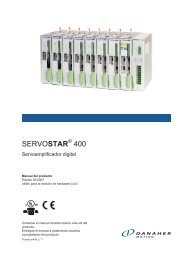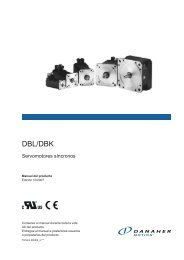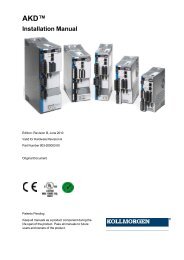SERVOSTAR™ 300
SERVOSTAR™ 300
SERVOSTAR™ 300
Create successful ePaper yourself
Turn your PDF publications into a flip-book with our unique Google optimized e-Paper software.
Technical description 07/2010 Kollmorgen<br />
6.10 Shock-hazard protection<br />
6.10.1 Leakage current<br />
Leakage current via the PE conductor results from the combination of equipment and<br />
cable leakage currents. The leakage current frequency pattern comprises a number of<br />
frequencies, whereby the residual-current circuit breakers definitively evaluate the 50Hz<br />
current. As a rule of thumb, the following assumption can be made for leakage current on<br />
our low-capacity cables at a mains voltage of 400 V, depending on the clock frequency of<br />
the output stage:<br />
Ileak = n x 20mA + L x 1mA/m at 8kHz clock frequency at the output stage<br />
Ileak = n x 20mA + L x 2mA/m at a 16kHz clock frequency at the output stage<br />
(where Ileak=leakage current, n=number of amplifiers, L=length of motor cable)<br />
At other mains voltage ratings, the leakage current varies in proportion to the voltage.<br />
Example: 2 x servo amplifiers + a 25m motor cable at a clock frequency of 8kHz:<br />
2 x 20mA + 25m x 1mA/m = 65mA leakage current.<br />
Since the leakage current to PE is more than 3.5 mA, in compliance with<br />
IEC 61800-5-1 the PE connection must either be doubled or a connecting cable with<br />
a cross-section >10mm² must be used. Use the PE terminals and the PE bolt in<br />
order to fulfil this requirement.<br />
The following measures can be used to minimise leakage currents.<br />
— Reduce the length of the engine cable<br />
— Use low-capacity cables (see p.51)<br />
— Remove external EMC filters (radio-interference suppressors are integrated)<br />
6.10.2 Residual current protective device (RCD)<br />
In conformity with IEC 60364-4-41 – Regulations for installation and IEC 60204 – Electrical<br />
equipment of machinery, residual current protective devices (called RCD below) can<br />
be used provided the requisite regulations are complied with. The SERVOSTAR <strong>300</strong> is a<br />
3-phase system with a B6 bridge. Therefore, RCDs which are sensitive to all currents<br />
must be used in order to detect any D.C. fault current.<br />
Rated residual currents in the RCD<br />
10 -30 mA<br />
Protection against "indirect contact" for stationary and mobile equipment,<br />
as well as for "direct contact".<br />
50 -<strong>300</strong> mA Protection against "indirect contact" for stationary equipment<br />
Recommendation: In order to protect against direct contact (with motor cables<br />
shorter than 5 m) we recommend that each servo amplifier be protected<br />
individually using a 30mA RCD which is sensitive to all currents.<br />
If you use a selective RCD, the more intelligent evaluation process will prevent spurious<br />
tripping of the RCD.<br />
6.10.3 Isolating transformers<br />
When protection against indirect contact is absolutely essential despite a higher leakage<br />
current, or when an alternative form of shock-hazard protection is sought, the<br />
SERVOSTAR <strong>300</strong> can also be operated via an isolating transformer (schematic connection<br />
see p.56). A ground-leakage monitor can be used to monitor for short circuits.<br />
Be advised to keep the length of wiring between the transformer and the servo<br />
amplifier as short as possible.<br />
42 SERVOSTAR <strong>300</strong> Instructions Manual




